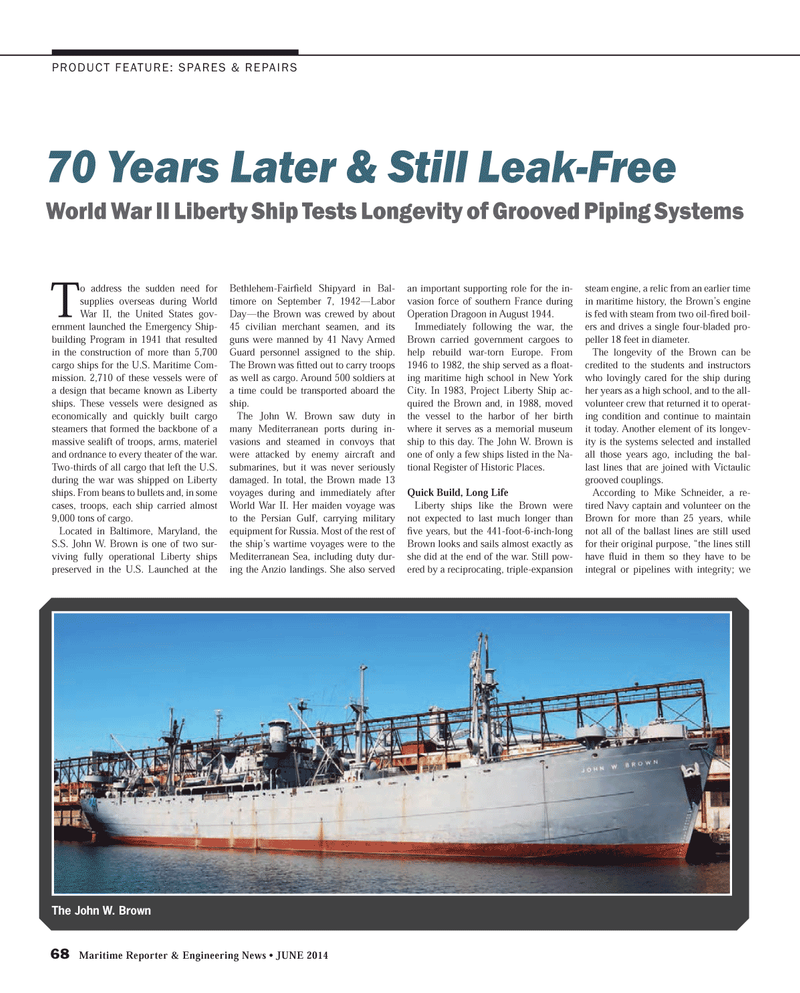
Page 68: of Maritime Reporter Magazine (June 2014)
Annual World Yearbook
Read this page in Pdf, Flash or Html5 edition of June 2014 Maritime Reporter Magazine
68 Maritime Reporter & Engineering News • JUNE 2014
PRODUCT FEATURE: SPARES & REPAIRS
T o address the sudden need for supplies overseas during World
War II, the United States gov- ernment launched the Emergency Ship- building Program in 1941 that resulted in the construction of more than 5,700 cargo ships for the U.S. Maritime Com- mission. 2,710 of these vessels were of a design that became known as Liberty ships. These vessels were designed as economically and quickly built cargo steamers that formed the backbone of a massive sealift of troops, arms, materiel and ordnance to every theater of the war.
Two-thirds of all cargo that left the U.S. during the war was shipped on Liberty ships. From beans to bullets and, in some cases, troops, each ship carried almost 9,000 tons of cargo.
Located in Baltimore, Maryland, the
S.S. John W. Brown is one of two sur- viving fully operational Liberty ships preserved in the U.S. Launched at the
Bethlehem-Fair? eld Shipyard in Bal- timore on September 7, 1942—Labor
Day—the Brown was crewed by about 45 civilian merchant seamen, and its guns were manned by 41 Navy Armed
Guard personnel assigned to the ship.
The Brown was ? tted out to carry troops as well as cargo. Around 500 soldiers at a time could be transported aboard the ship.
The John W. Brown saw duty in many Mediterranean ports during in- vasions and steamed in convoys that were attacked by enemy aircraft and submarines, but it was never seriously damaged. In total, the Brown made 13 voyages during and immediately after
World War II. Her maiden voyage was to the Persian Gulf, carrying military equipment for Russia. Most of the rest of the ship’s wartime voyages were to the
Mediterranean Sea, including duty dur- ing the Anzio landings. She also served an important supporting role for the in- vasion force of southern France during
Operation Dragoon in August 1944.
Immediately following the war, the
Brown carried government cargoes to help rebuild war-torn Europe. From 1946 to 1982, the ship served as a ? oat- ing maritime high school in New York
City. In 1983, Project Liberty Ship ac- quired the Brown and, in 1988, moved the vessel to the harbor of her birth where it serves as a memorial museum ship to this day. The John W. Brown is one of only a few ships listed in the Na- tional Register of Historic Places.
Quick Build, Long Life
Liberty ships like the Brown were not expected to last much longer than ? ve years, but the 441-foot-6-inch-long
Brown looks and sails almost exactly as she did at the end of the war. Still pow- ered by a reciprocating, triple-expansion steam engine, a relic from an earlier time in maritime history, the Brown’s engine is fed with steam from two oil-? red boil- ers and drives a single four-bladed pro- peller 18 feet in diameter.
The longevity of the Brown can be credited to the students and instructors who lovingly cared for the ship during her years as a high school, and to the all- volunteer crew that returned it to operat- ing condition and continue to maintain it today. Another element of its longev- ity is the systems selected and installed all those years ago, including the bal- last lines that are joined with Victaulic grooved couplings.
According to Mike Schneider, a re- tired Navy captain and volunteer on the
Brown for more than 25 years, while not all of the ballast lines are still used for their original purpose, “the lines still have ? uid in them so they have to be integral or pipelines with integrity; we 70 Years Later & Still Leak-Free
World War II Liberty Ship Tests Longevity of Grooved Piping Systems
The John W. Brown
MR #6 (66-74).indd 68 6/9/2014 11:32:47 AM

 67
67

 69
69
